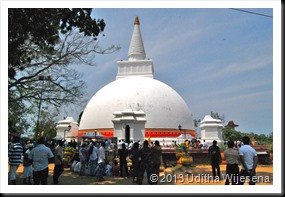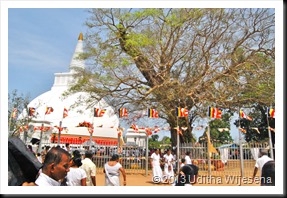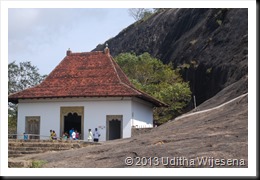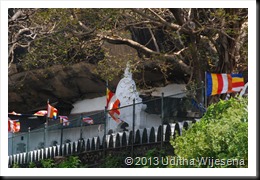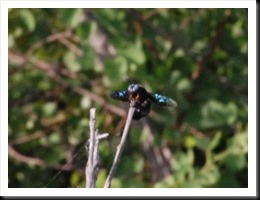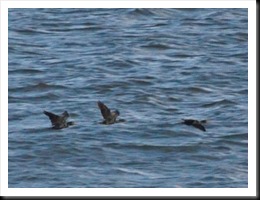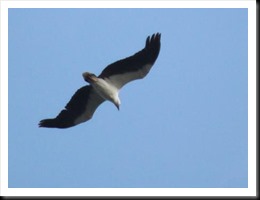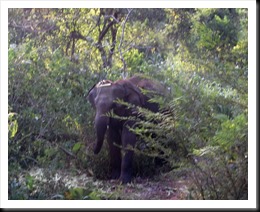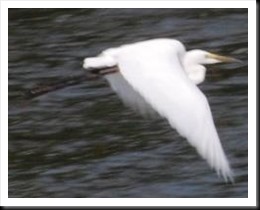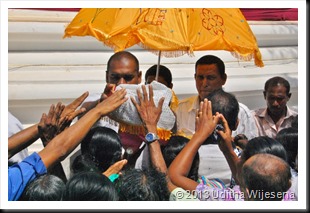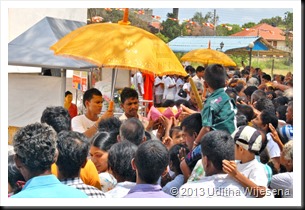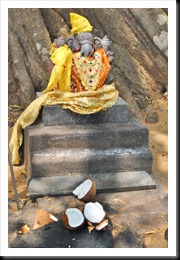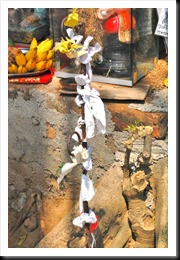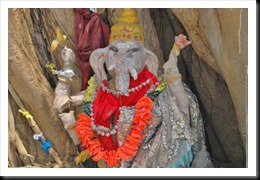Sri Lanka, this thrice blessed land by the Buddha, is said to have changed spiritually, culturally and politically with the arrival of Arahat Mahinda in the 2nd century BC during King Dewnapiyatissa’s reign. It is this cultural change that created the magnificent stone architecture of Samadhi and Auwkana Buddha statues of Anuradhapura and the immaculate Gal Vihara of Pollonnaruwa
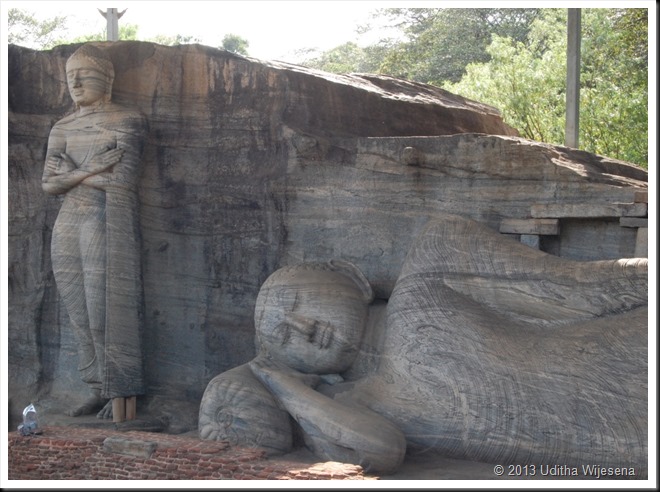 |
| The immaculate Gal Vihara in Pollonnaruwa |
However one needs to be mindful that the engineering ingenuity of the Sri Lankan Hydraulic Civilisation and their knowhow of soil mechanics and soil engineering which created wondrous reservoirs and aqueducts was a unique speciality of this land long before the social transition that came with Arahath Mahinda.
The most universal Buddhist architectural symbol the Stupa was first built in Sri Lanka in the 5th Century BC. It was the Buddha himself giving its design to Thapassu and Balluka the merchant friends who wanted to build a memorial to honour him. Buddha is said to have folded one of his robes into a square and placed his upturned begging bowl and the umbrella on top of it, thus outlining the basic shape of the dagoba or stupa. Upon the request of the merchant friends for an object for veneration, Buddha offered them the Sacred Kesha Datu, [a lock of hair]. It is by enshrining this sacred Kesha Datu that the Girihandu Seya was built by Tappassu and Balluka in Tiriyaya a northerly location beyond Trincomalee in Sri Lanka. Numerous are the stupas that were to be built on this land ever since.
Somawathiya is one such stupa that came up in the 2nd century BC. It was built by Prince Giri Aba on the request of his wife Somawathie [the sister of King Kavantissa of Ruhuna, aunt of Dutugemunu]. It was built in Somapura on the banks of the Mahaveli enshrining the sacred right tooth relic of the Buddha gifted to the prince by Arahath Mahinda. The site was maintained by royal decree until the 4th century AD. The sacred Somawathiya is said to have been renovated by King Kannitta Tissa, King Kurtakanna Tissa, King Gamini Abhaya and King Amanda Gamini according to the chronicles.
Renovated Somawathiya today
Today it is in the remotest location away from habitation hidden in the left bank jungles of the Mahaweli floodplain beyond Pollonnaruwa threatened by the annual flooding of the Mahaweli.
The Vesak full moon day in the month of May is a holiday in Sri Lanka; commemorating the birth, enlightenment and the passing away or the Buddha. This year [2013] it occurred on a Friday providing a three day weekend. Making the best use of the three days we planned to celebrate Vesak by making a pilgrimage to this remote location in Somawathiya. The journey was planned by the young cousins of our second generation, we older folk had only to make the financial contribution and enjoy a comfortable trip in luxury.
On Friday 24th May 2013, 18 of us, fathers and mothers, sons and daughters, uncles and aunts, brothers and sisters, were off to Giritalle via Dambulla en-route to Somawathiya. We would spend the night at the Giritalle Hotel and leave for Somawathiya on Saturday the 25th.
Leaving Colombo as dawn was breaking everyone was in a quiet doze all the way to Kurunegala for a general wakeup about breakfast time. We were carrying packed breakfast intending to have it on the way at the Badagamuwa forest patch; there was hardly a location to park the bus at Badagamuwa, there was so many travelling out on pilgrimages just as us……. We proceed further to the Melsiripura forest patch instead. Breakfasted we head to the Dambulla cave temple to take part in the Vesak veneration with the masses. Dambulla is the largest and the best preserved rock cave Buddhist temple in the country.
 |
 |
| Dambulla the largest cave temple in Sri Lanka |
Around two hours spent in Dambulla we leave for Giritalle just before noon to our retiring location for the night. The forest foliage was in lush green after the bountiful rains that fell on this land this year bringing a flood after flood to the otherwise dry parched land. All the large reservoirs and the village irrigation tanks are full to the brim showing signs of a bumper paddy harvests in the coming season.
Passing Habarana the right side windows of the bus is filled with one panoramic vista of a sheet of water spreading as far as the eye could see to a distant horizon. It is the Minneriya tank in its full capacity… distributing the waters to the paddies and other ancillary tanks in Hingurakgoda, Kaudulla and Giritalle.
 |
| Minneriya Tank a continuous sheet of water |
We stop at the Minneriya Army Gunners Club for refreshments and lunch. The thirty year war in the country that ended in May 2009 had brought up various army cantonments that came up for defence and vigilance in this part of the country connecting the North and the East of Sri Lanka. These units are now blending with the civil society providing vital travel needs of the people who are scaling the length and breadth of this land since peace set in. The series of washrooms in this location is worth mention of its spotless cleanliness serving the traveller for just a mere Rupees 10/=.
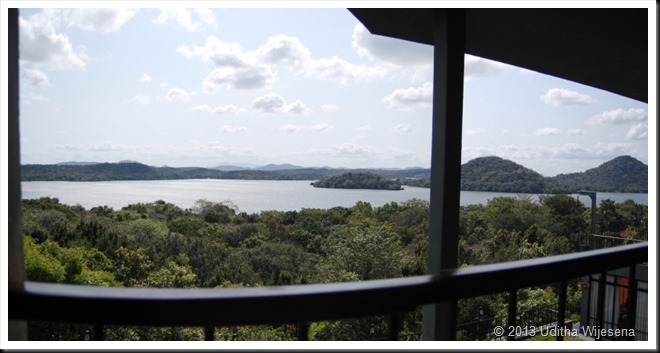 |
| Picturesque Giritalle Tank |
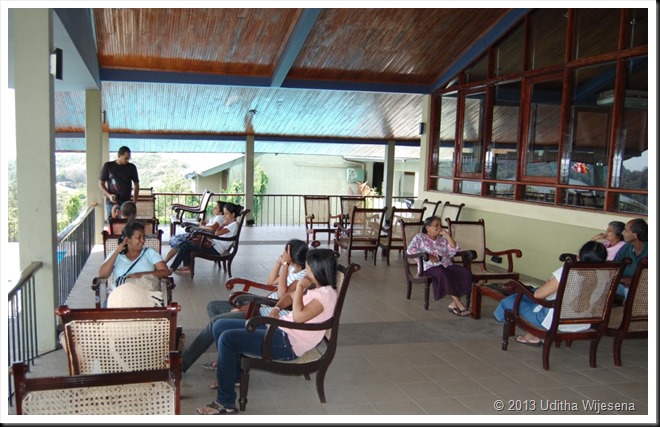 |
| Giritalle Hotel Lounge |
Its check-in time at the Giritalle Hotel, located on a high ground overlooking the picturesque Giritalle irrigation tank. We have extra time and decide to make a visit to the Minneriya National Park, a famous location to view elephants in their numbers. However it was to be a mere flop as it was the wrong time of the year when the tank is full and the gracing grounds inundated. The park officials need to be more responsible in educating the public of what is available within the park seasonally. Three jeeps hired for about an hour and half we just see a bumble bee, a few birds and of course the different vegetation within the park for a fee of Rupees 15,000.00. Three elephants were seen outside the park scavenging on the roadside stalls selling boiled Indian corn.
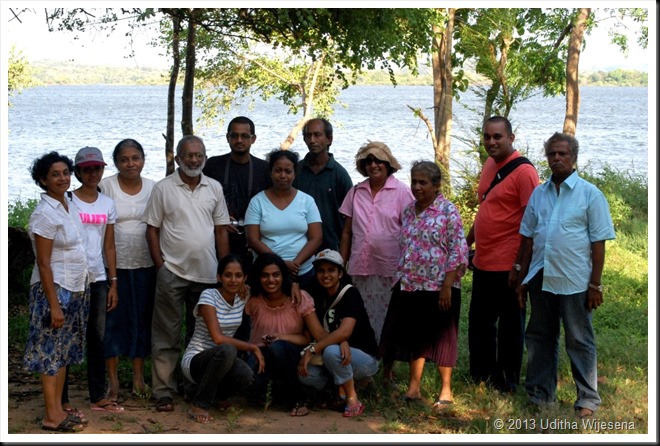 |
| The Team |
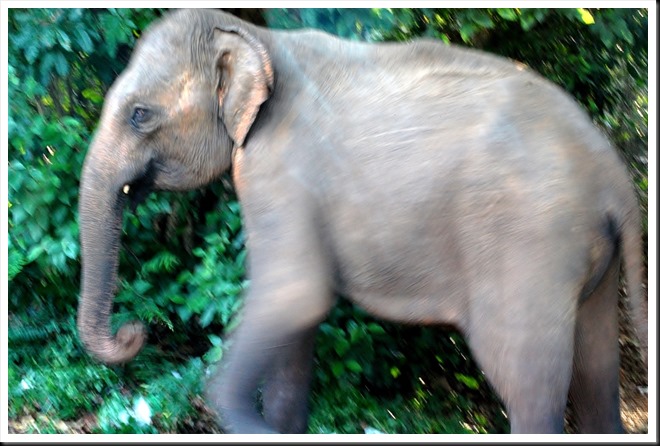 |
| Minneriya Park birds and scavenging elephants |
Night falls…and we are back in the hotel, a swim in the pool and to a sumptuous dinner with the bar saying it’s closed today in keeping with the law of the land, we retire for the day. [Liquor and meat stalls don’t sever on full moon days in Sri Lanka]
It’s a sunny morning in Giritalle; we are at breakfast clad in white for the pilgrimage. Bags packed and loaded, by 8.00 a.m. we leave for Somawathiya. The driver inquires of the best motor-able road from a passer-by and someone from within the bus says the Google Navigation says to take a left turn at the next intersection. It is the Smart Phone Era. We keep navigating until we come to a difficult road. No matter… a de-tour is taken and we are at Somawathiya, already crowded and busy.
All religious festivities the world over is a mere cultural and spiritual gathering. Somawathiya on Vesak was a hive of activity. There were souvenir sellers, food vendors, and soothsayers. Flowers for offering and oils for the lamps that burn continuously year round is for sale to the unplanned visitor. There is the different type as well; if you need a tattoo done to remember your visit, it is available in the most unhygienic way. The man under the tree is at your service. No guarantees, no after sales service.
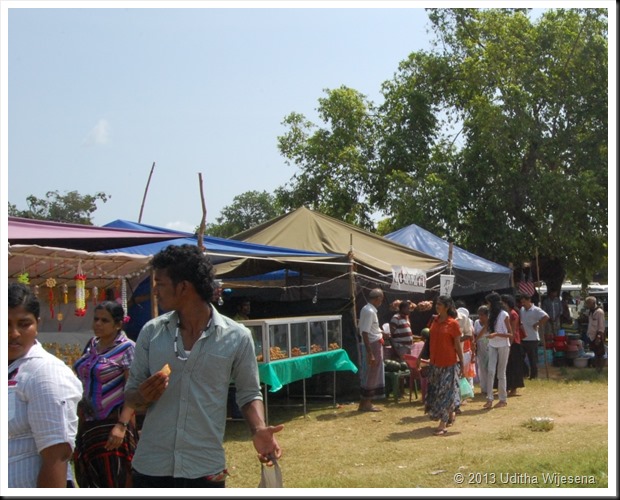 | ||
| Food stalls |
 |
| Souvenirs to be taken away |
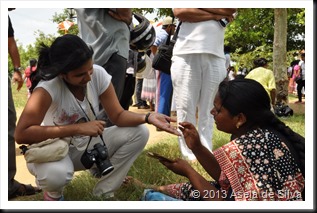 |
| Your future in the palm? |
 |
| A busy day for soothsayers |
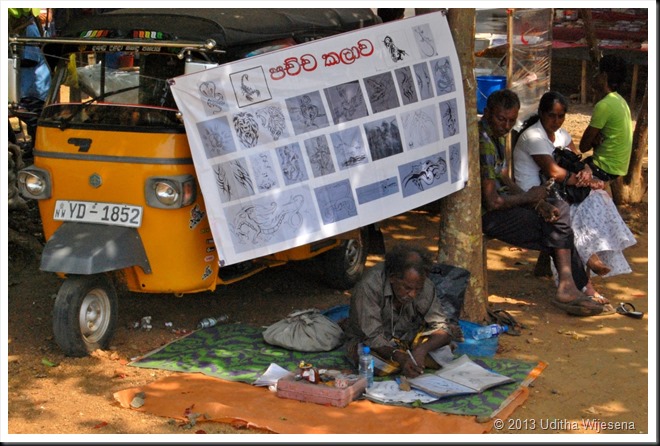 |
| A tattoo to remember your visit ..... |
 |
| Norman Maama [Uncle] crushing ice for orange juice.. ..... ice is stored in gunny sack under the table |
We were just in time to the Buddha Pooja [offerings to the Buddha] activity at Somawathiya which commenced with the procession carrying a long fabric in the form of the Buddhist ensign long enough to wrap-round the base of the stupa. This was followed by the offerings passed round the masses who thronged about to touch them wishing for merit; your ears are filled with Saduh…..Saduh…..Saaaaaa….., the drumming and the conch blowing. With these activities the morning ceremonies at Somawathiya for the Vesak celebrations came to an end.
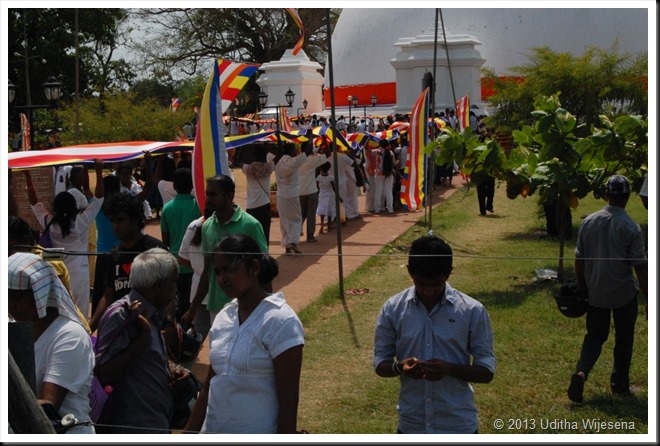 |
| A Buddhist ensign long enough to go round |
 |
| Collective effort |
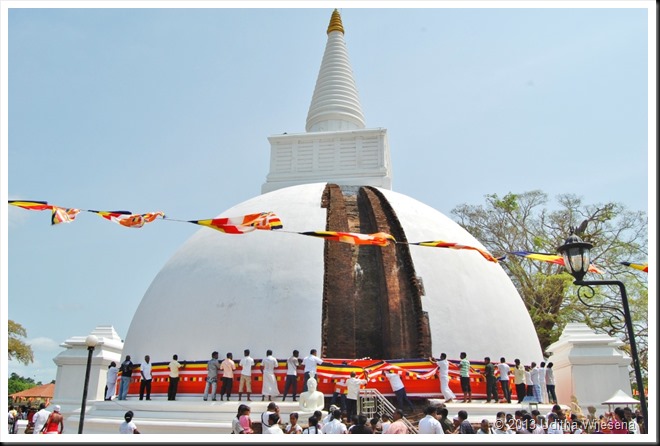 |
| Layers of bricks showing the renovations with time |
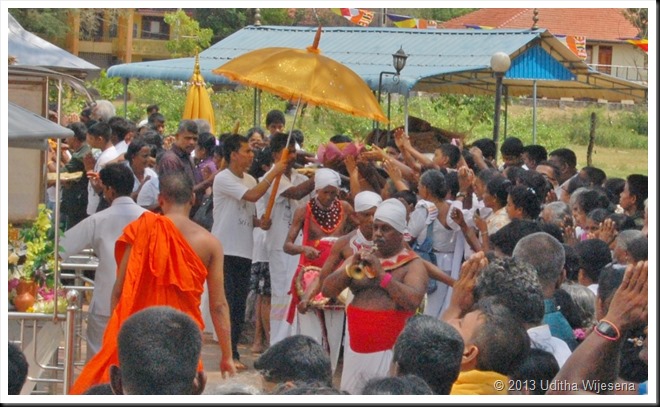 | |||
| Your ears filled with the drums and brass |
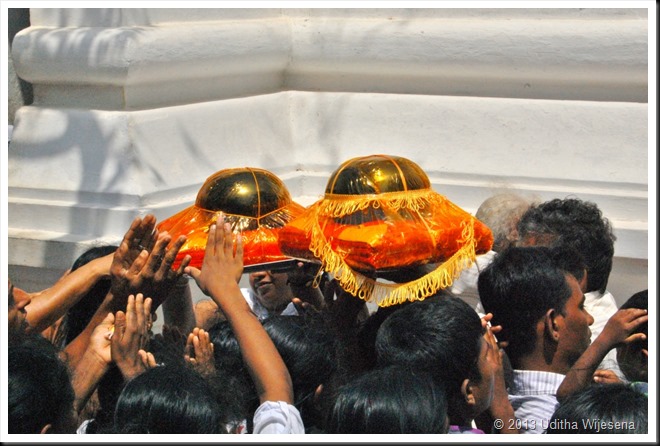 | |
| The touch of merit |
Somawathiya Stupa was inaccessible for the last 30 years due to the civil war that prevailed in the country but the Sri Lanka Navy and the Army mobilized in the flood pain to check the terrorist transition from the North to the East attended to the needs and rituals of the stupa. Somawathiya being in this remote location is shrouded with many superstition of supernatural lighting seen around the stupa and many other mysterious encounters witnessed by devotees. Some could be explained scientifically while some are mysteries to this day.
[Refer similarities seen by author in Sri Pada or Adams peak.]
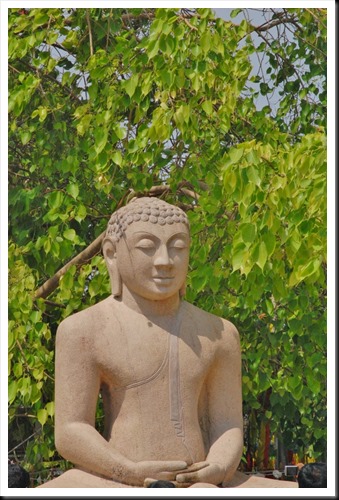 |
| A modern day Samadhi statue |
However people in the dry zone of Sri Lanka are still in the habit of offering rituals and venerating the mythical elephant headed Hindu God Ganapathy known as Aiyanayake Deviyo, the guardian god of the dry zone of Sri Lanka. Somawathiya today is under state patronage and much is the development in the upgrading of the road network, making it accessible from many directions. It would no longer be remote but still be affected by the annual flooding of the Mahaweli.
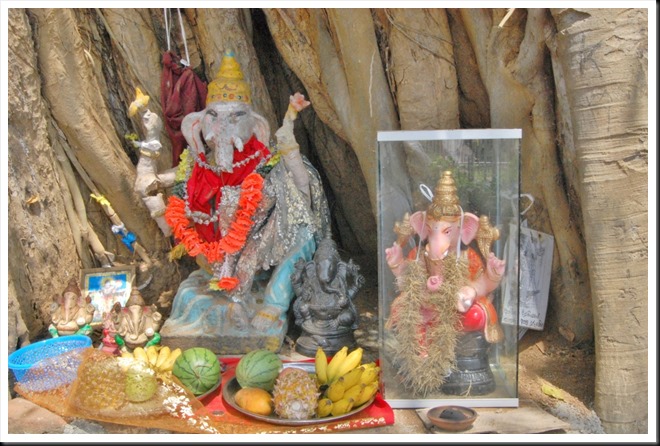 |
| Ganapathy or Aiyanayake is still the guardian |
Way back to Pollonnaruwa, I am a curious man, thinking why did the ingenious Sri Lankan engineer go land a stupa in a most unsuitable location in the flood plain of the largest river that overflowed every year marooning man and beast? It was then that I found that there had been others researching on the subject and it is seen that the river has changed course during the 2500 years it flowed by. There is evidence to say that Somawathiya now on the left bank of the Mahaweli was originally located on the right bank. The change of the river course is related to the flooding and there is speculation to say that it was this reason that contributed to the collapse of the hydraulic civilization of the Raja Rata making the exodus of the masses to the central hills and created the Kandian Kingdom in the Malaya Region.
The Mahaweli Floodplain.
The Mahaveli flood plains itself is of much interest. Today it is a sanctuary among many forested areas declared as National Parks or Sanctuaries protecting the catchment areas of the reservoirs built for irrigation and power generation under the accelerated Mahaweli Development Scheme.
Before the Mahaweli Scheme the area beyond Pollonnaruwa, the said flood plain was a very busy cattle grazing ground of the nomadic Moorish herdsman [colloquially called Mattayar / man from Mattakalappu or Batticaloa] of the eastern province. This was the time when the beef eating habit of the Sri Lankan Sinhalese was at its peak. The cattle breed named the ‘Thamankaduwa White’ was a breed confined to the eastern province of Sri Lanka and was the primary source of beef in the country.
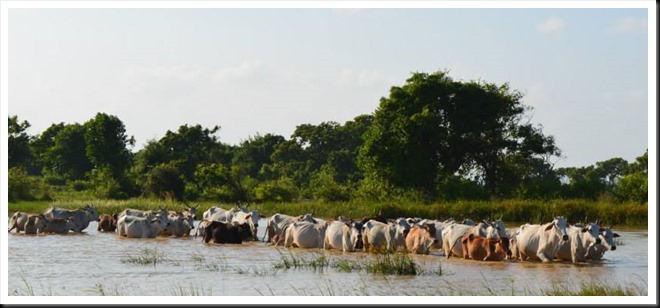 |
| Thamankaduwa Whites in the floodplain |
The nomadic eastern herdsman used to grace their cattle in the paddy lands of Batticaloa and Samanthurai during the non-cropping season, while during the cropping season the cattle was herded up north into the Mahaweli flood plain which was full with vegetation after the recession of the floodwaters. The cattle were fattened in these plains, and when the time was right for the southward journey the excess animals were sold for meat and they were transported by train to Colombo for slaughter. The calves and cows were now herded back southward to Batticaloa leaving the plains to re-generate with the flooding. This was a seasonal occurrence until the majority Sinhalese did away with the habit of beef eating. Sungawila the last township on high ground is predominantly Moorish. It was here that the herdsmen put up camp and the sale of cattle took place. Today the Sungawila Moor is a paddy farmer and the herding practice no more. It’s discouraged for it brings destruction to the environment from over grazing and excessive hoof traffic contributing to erosion and damage to the undergrowth.
It is this phenomenon that I suppose was the basis for the popular song by the late lyricist Premakirthi de Alwis and sung by Sunil Edirisinghe narrating the torturous journey of the cattle coming into Colombo for slaughter by train.
“Banen benda rajarata pedesinne…………..”
http://www.sinhalajukebox.org/cgi-bin/songs.cgi?action=Lyrics&s=A0120016C01

